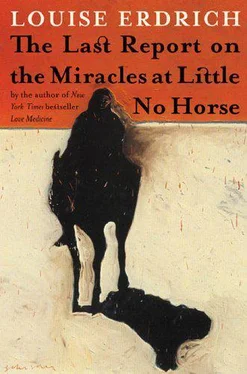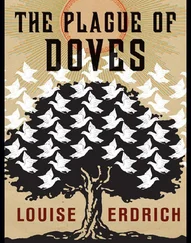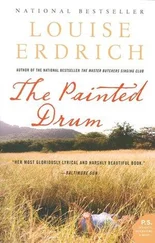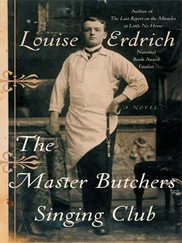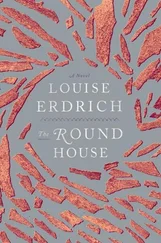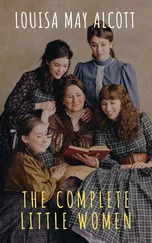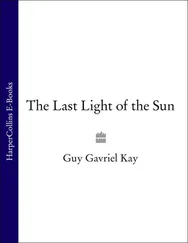She looked at him with pity and scorn.
“There is something,” Father Damien tried to explain to Hildegarde, “profound about her suffering. And she is most intelligent. I’m afraid she can’t be kept at the government school, and an asylum would destroy her.”
“Yes, Father,” said Hildegarde perfunctorily, as she did when he became, to her mind, either too fanciful or too tender of heart.
“I have an idea about the uncle, as well. Her hatred of the man is abnormally intense.”
“She’s mad,” said Hildegarde flatly.
The nun’s stubborn pragmatism annoyed Agnes, but at the same time she could not quite wrestle the proper evidence to life. Why had grief given this particular task to Mary Kashpaw? Perhaps the girl was looking for something buried, maybe the way a dog hides a bone and forgets exactly where. Maybe she’d needed this object, too well hidden. Later, her plan began to take on a cosmic shape. Agnes tried to think of the excavations as a design with some strategy. If birds viewed it from above, what would they see? She took the large view but saw only a tangle of upsettingly random desecrations of the spring undergrowth — it made no sense. And by that lack of law it made no sense, either, to place upon the girl’s actions any rational construction. She was digging. The purpose must be poetic, thought Agnes. Perhaps only poetry could explain it, and Father Damien was a priest.
In fact, the answer would come slow and only by degrees over days, until it was entirely explained in a dream: she herself was digging when she uncovered a dream Kashpaw and a dream Quill who rose, brushed off their clothing, and complained of the coldness of the earth. Fetch my daughter , Quill said to Agnes, for the man hurts her. Agnes woke knowing that Napoleon had done something terrible to the girl. Now Mary Kashpaw was looking for her parents for protection, and to soothe her. Agnes also realized that Kashpaw and Quill held Father Damien responsible.
The next morning, Agnes went to visit. Mary Kashpaw’s ravaged stare struck her as more than a look — it was a passageway between this reality and the next. The Kashpaw girl had entered a dark peace from which she would never be disturbed. She sat on a solid mental ledge and frowned passively upon the world, a great brooding child who was too well traveled a visitor in the dream world and the land of the dead. The only place for Mary Kashpaw was the convent itself, or at least the grounds of the church — she didn’t like to sleep indoors. The girl must come to live near Father Damien.
At his insistence, Bernadette drove the girl to the convent, where she was to live for the rest of her life. When Mary Kashpaw got down from the wagon seat upon which, curiously, she seemed much at home, untroubled by the frightful events that drove her into silence, Agnes felt a curious twist. Her theory of rescue was upended by an acute intuition. The girl’s presence was all of a sudden reassuring. As Agnes approached and took the girl’s hand she understood, with a positive prescience, that Mary Kashpaw had come to shield her and heal her — how, there was no saying.
Mary Kashpaw ate more than all of the nuns put together, but when food was scarce she gathered her own, and then some. She was discovered chewing wild tonic of fresh dandelion spears from the borders to the nun’s path and munching green apples; sometimes she made herself a stew of gopher and acorns, stolen eggs from the nests of finches and doves, wild currants, cattail root; she gnawed a gum of spruce and occasionally, for the nuns, snared a rabbit or mesmerized a grouse in the weedy graveyard. If all else failed, she brought them a meat she called “ground meat,” already skinned and boned, so it was quite some time before they realized it was named for its habitation — it was snake. She could always catch bullheads and frogs. She knew well just how to survive. With her mother’s slim height and her father’s powerful build, she grew into an arresting presence, though she seemed content to turn her back upon the world.
Summers, she slept in the shack where the sleigh was kept, made a bed on the hard seat and curled up like a babe. In winter, she made a pallet on the convent floor behind the kitchen stove. Her prayers were constant, a mutter just under her breath. Surely, her piety found favor in God’s eyes. The sisters envied her simplicity a little and grudged her the loaf of bread she ate each meal. She had no shame — hooked her skirt between her legs, fastened it in her belt like a great wide diaper when she wanted freedom of movement. Her thighs were rock hard and golden. The nuns made trousers for her, underwear, modest bloomers and knit socks, but she just shed them in the joy of her work. Set to the task of planting, she sowed with a matchless fervor and whacked new ground clear in a disturbing contest of joy. Carefully, Father Damien kept from her all sight of shovels. Mary Kashpaw hoed and chopped, whitewashed every wall with a profligate arm, cut weeds, used a scythe with frightful intelligence, polished every pew and wooden surface with beeswax, but her favorite occupation, the work to which she brought the same passion with which she dug, the work that made her so happy that she was heard humming tunelessly and brashly to herself, was chopping wood. It became known all around that she was prodigious, as in the yard great stout piles mounted.
Each stroke was part of her devotion, all seamless, all one. She lent herself to chopping with a prayerful precision and grace, and she smiled modestly and blessed herself when she was done. She slept with her ax, filed it, kept it sharp and clean. As long as she was occupied — they soon hired her out — she attended every Mass, sang with the sisters at every funeral. She made her confession twice weekly, a silent confession that consisted of a tap on the screen and a whisper like the sigh of windblown grass. For her penance, Father Damien rarely gave her more than one Hail Mary to mouth into the clasp of her palms. How could he assign more? She committed no sins. Men were no more to her than the dust in her sleeping robes. Her life was simple. All lies fled past her. She was immaculate of envy. She grew up in no one’s shadow and cast her own in solitude. She lived in such exclusive discipline that it seemed to Agnes that the girl was preparing herself, for what, Agnes did not know until it came upon them.
INFLUENZA
1918
Only one road led in and out of the reservation. There was no question. Disease came down the whiteman’s road. Some heard it approach with slithering steps, foul and mawkish. Zozed Bizhieu met a man whose appearance arrested her. Great white patches of skin gleamed on his skull and strings of orange hair fell to his shoulders. His face was ravaged, and so thin that his teeth stuck out. He was made of spikes and sticks. Way up high, his skull bobbed, skin white as paper, mouth blood-red. His nose bled, she told Damien. His lips were a blistered purple. His eyes wept black bile and suddenly he fell dead at her feet. When she leaned over to assist him, he laughed as he melted into the earth, and the rank and rangy mutt that shivered at his side ran off, onto reservation ground, howling a deadly breath. Zozed was always seeing things, reporting, but some believed in this uncanny messenger because they’d heard rumors of the illness already.
The Spanish influenza was reported in the papers, which people now bought because six Anishinaabeg men had joined the great war of the chimookomanag. The newspapers reported that the disease was marching all over the world and working hard harvesting the young, old, fragile, and sturdy. Making no distinctions in its eager rush. People hoped that the sickness would be tired by the time it got to the reservation, but, no, when it hit, the illness struck with a young exuberance. Descended, really, on the wings of ducks, in the bones of clouds, on city wagons, and in the pockets of used clothes. It came in meat and on the skin of potatoes. It was waved off the trader’s hands, and dusted tongue to tongue with the Communion Hosts served from Father Damien’s fingers.
Читать дальше
